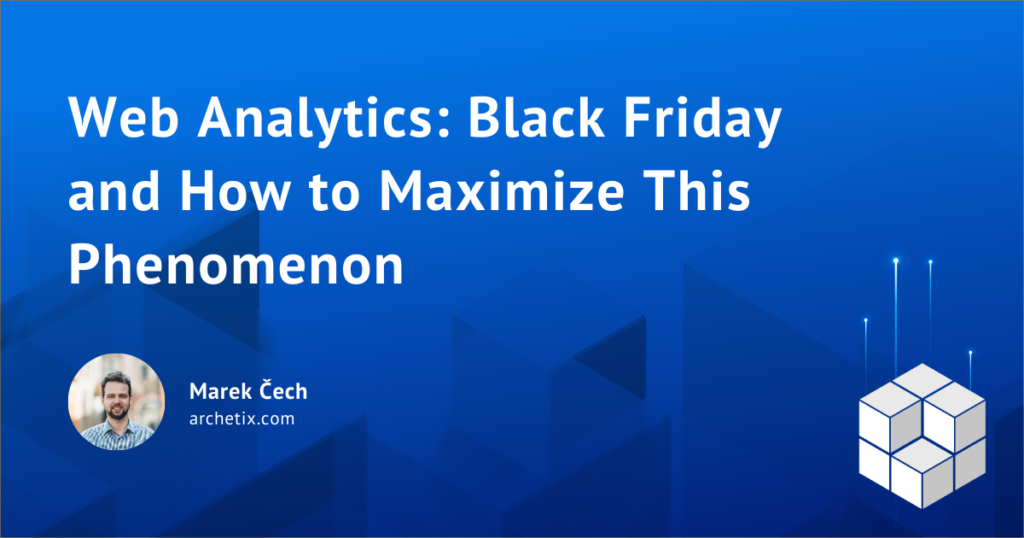Black Friday is not only one of the biggest shopping events of the year, kicking off the holiday season, but also a fantastic opportunity to leverage web analytics to its fullest potential. How can you maximize the value of Black Friday through data and precise measurement?
Let’s take a look at this through the lens of web analytics and its related benefits.
In this article, we would like to present strategies on how web analytics can support your Black Friday efforts, and why it’s crucial to have the right data measurement in place, not only in Google Analytics 4, Google Ads, and other advertising systems, including Facebook Pixel. In recent years, Czech consumers have become accustomed to large discounts, making Black Friday a key event in e-commerce. Therefore, having a strong marketing and measurement strategy with properly configured data collection is essential. With these factors in place, you can easily and accurately measure the success of your campaigns and messages.
Here are some key points and tips from our analysts before launching your Black Friday marketing campaign:
1. Precise Conversion Setup and Event Tracking
Set up key conversion events: Ensure that you are tracking all major steps in the purchase journey, such as “Add to Cart” and “Complete Purchase.”
E-commerce data collection: Track critical metrics like order values and discounts, which allow you to analyze the effectiveness of product campaigns.
Conversion funnel: Setting up a conversion funnel helps identify where customers drop off, making it easier to optimize these steps.
As you probably know, modern and automated activities today rely heavily on this data. Without it, it’s impossible to create relevant target audiences, which are then synced with systems like Google Ads and deliver targeted ads.

2. Integration of Measurement Pixels (Facebook, Google Ads, TikTok)
Setting up measurement pixels correctly for key advertising platforms like Facebook, Google Ads, and TikTok is crucial during Black Friday. These pixels enable you to track the effectiveness of your campaigns, optimize conversions, and leverage remarketing audiences to maximize your campaign reach and efficiency.
Correct pixel setup:
- Check basic setup: Ensure that measurement pixels are correctly installed on all relevant pages (e.g., product page, add to cart, purchase completion).
- Configure specific events: Set up specific events for what you want to track, such as “ViewContent” (product page view), “AddToCart” (add to cart), and “Purchase” (purchase completion).
- Testing with diagnostic tools: Use diagnostic tools like Facebook Pixel Helper or TikTok Pixel Helper to check that the pixels are working properly and to identify any errors.
Leveraging pixel data for remarketing and campaign optimization:
- Remarketing to specific audiences: Create remarketing campaigns targeting users who have already visited your site or added items to their cart but didn’t complete the purchase. This will increase the likelihood of them returning to finish their purchase.
- Dynamic ads for abandoned carts: Dynamic ads allow you to automatically display products that users viewed or added to their cart. This personalized strategy can significantly increase conversion rates.
- Real-time campaign optimization: Measurement pixels provide real-time data, allowing you to monitor which ads are delivering the best results. You can optimize campaigns during Black Friday based on up-to-the-minute results.
Cross-platform integration:
- Unifying pixels and analytics: If you’re using multiple platforms, ensure that data from the pixels is reflected in your main analytics tool (e.g., Google Analytics or Looker Studio) for an overview of overall performance.
Maintaining data consistency: Verify that events and conversions are consistently defined across platforms, ensuring uniform results when evaluating campaign performance.

3. Target Audience Segmentation
Segmentation is key for creating targeted campaigns that effectively address different customer groups. During Black Friday, you can maximize campaign effectiveness by reaching the right customers with the right message. Detailed segmentation will help you better understand customer needs and tailor campaigns to increase conversion rates and return on investment.
Basic segments for Black Friday campaigns:
- New vs. returning customers: Create separate campaigns for new and returning customers. Attract new customers with a first-purchase discount code, while returning customers may appreciate a loyalty program or exclusive offers.
- Abandoned carts: The abandoned cart segment is highly valuable. Remind customers of the products they viewed or offer them a small discount to encourage them to return and complete the purchase.
- High purchase frequency vs. low purchase frequency: Regular customers can be motivated with higher discounts or premium offers. For customers with low purchase frequency, offer incentives like free shipping to encourage them to buy.
Advanced segmentation based on behavior and preferences:
- Interest in specific product categories: If you have data on customers’ interest in specific product categories, create segments focused on these categories. For example, offer personalized deals on electronics to customers who frequently purchase tech products.
- RFM analysis (Recency, Frequency, Monetary Value): This analysis helps segment customers by when they last purchased, how often they shop, and how much they spend. This approach allows you to target customers with the highest likelihood of purchase.
- Demographic segmentation (age, location, gender): Demographic data helps you tailor your messaging and offers to suit different demographic groups. For instance, younger audiences may appreciate trendy items, while older groups might value reliability and value-for-money offers.
Personalized campaigns by segment:
- Personalized offers and messaging: For each target group, craft tailored messages—e.g., “special offer for returning customers” or “exclusive Black Friday discount for loyal customers.” Personalizing campaigns can increase customer interest and improve the overall user experience.
- Dynamic content and emailing: Send personalized emails to segmented groups with dynamic content, such as recommended products or limited-time discounts. Emails tailored to customer interests typically have higher open and click-through rates than generic messages.
4. Website Performance Optimization and Load Speed
Increased traffic can easily overwhelm your website, leading to slow loading times and a higher rate of abandoned carts. Website performance is critical during Black Friday to ensure that visitors can navigate the site smoothly and complete their purchases.
Server load testing: Perform load tests to check if your server can handle increased traffic. If needed, consider scaling server capacity or using cloud services to ensure fast page loads.
Mobile optimization: Over half of visitors may come from mobile devices. Ensure that your website is fully optimized for mobile in terms of both speed and user experience.
Reducing content size: Compress images, remove unnecessary plugins, and optimize scripts to significantly improve page loading times. Invest time in code adjustments and simplifying the website structure for faster loading.

5. UTM Parameter Setup and Campaign Tracking
UTM parameters allow easy tracking of traffic sources and the performance of individual campaigns. They give you a clear overview of which campaigns are driving the most conversions, enabling you to optimize your marketing budget effectively.
Consistent campaign labeling: Ensure all campaigns and channels are properly labeled with UTM parameters so that results can be easily analyzed and compared.
Real-time tracking: Set up a real-time campaign dashboard to monitor changes in performance across channels. Changes in campaigns during Black Friday can have an immediate impact, so having access to live data is essential.
Evaluating channel performance: UTM parameters help track which traffic sources (e.g., email, social media, PPC ads) bring in the most conversions. Based on this data, you can dynamically reallocate your budget throughout the day.
6. Return on Marketing Investment (ROMI) Measurement
To effectively track the return on investment (ROI) for your campaigns during Black Friday, you need to closely monitor how much you’re spending on each channel and the results it yields. ROMI reporting allows you to quickly determine where your investments are delivering the best outcomes.
Overview of costs and revenues: Breaking down the budget by channel helps you identify where it’s most effective to invest more and where you can cut back. Tracking revenue from individual campaigns provides insight into their true effectiveness.
Regular reporting: During Black Friday, having ROMI reporting in real-time is invaluable for evaluating campaign success. It will provide a clear picture of which channels are delivering the expected results.
Long-term optimization: Data from Black Friday can also inform long-term planning. You can use it to optimize budgets for future major events and improve strategies for upcoming campaigns.
7. Impact of Discounts on Average Order Value
During Black Friday, the average order value often decreases due to discount offers. It’s important to monitor whether the discounts are delivering sufficient profits and not causing losses.
Tracking discounts and coupon usage: Prepare a report that records which discounts and coupons were used during purchases. This helps analyze the impact of individual offers on order values.
Evaluating the profitability of discounts: Monitor whether the discounts are generating enough profit. It may be useful to analyze if a certain discount amount brings higher purchase volume or if offering a higher average order value is more beneficial.
Year-on-year comparison: Compare the average order value with the previous year to see how discounts have impacted revenue and profitability in the long term.
8. Customer Journey Analysis and Abandoned Carts
Black Friday brings increased traffic, which often means the customer journey to purchase can be longer or more complex. Track where visitors drop off in the purchase process and analyze any potential issues.
Monitoring abandoned carts: A rise in abandoned carts may indicate issues with user experience or cart clarity. Analyzing these steps can reveal obstacles that prevent customers from completing their purchase.
Exit intent and retargeting: Use tools like exit intent pop-ups or retargeting ads to remind customers to complete their purchases. This can help reduce abandonment rates during Black Friday sales.
9. Post-Black Friday Review and Future Strategy
Once Black Friday concludes, it’s crucial to analyze the results and derive insights for future campaigns. Use web analytics to assess the impact of your strategies, identify areas for improvement, and learn what worked best.
Post-campaign evaluation: Conduct a thorough post-mortem review of your campaigns. This will provide insights into customer behavior, spending patterns, and which marketing strategies were the most effective.
Identify new growth areas: Based on customer data from Black Friday, you may identify new growth areas or product categories to focus on in the future.
Long-term improvements: Identify areas for website, content, and marketing optimization based on your findings. Continuous improvement based on data is key to staying competitive in the e-commerce market.
By carefully planning, setting up the right data measurement tools, and analyzing Black Friday’s performance with the help of web analytics, you can maximize the effectiveness of your campaigns and achieve a significant return on your marketing investment.
Properly set up measurements and data tracking are key tools for achieving success in this important sales event. And Archetix are here for you! We will be happy to help you with the implementation of the needed measurements. Make an appointment with us!

